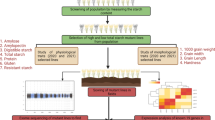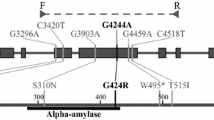Abstract
Given the important role that starch plays in food and non-food uses of many crops, particularly wheat, efforts are being made to manipulate its composition through modification of the amylose/amylopectin ratio. Approaches used to achieve this goal include the manipulation of the genes involved in the starch biosynthetic pathway using natural or induced mutations and transgenic methods. The use of mutagenesis to produce novel allelic variation represents a powerful tool to increase genetic diversity and this approach seems particularly appropriate for starch synthase genes for which limited variation exists. In this work, an EMS-mutagenised population of bread wheat cv. Cadenza has been screened by combining SDS–PAGE analysis of granule bound starch proteins with a TILLING (Targeting Induced Local Lesions IN Genomes) approach at the gene level. In particular we have focused on two groups of synthase genes, those encoding the starch synthase II (Sgp-1) and those corresponding to the waxy proteins (Wx). SDS–PAGE analysis of granule bound proteins allowed the identification of single null genotypes associated with each of the three homoeologous loci. Molecular characterization of induced mutants has been performed using genome specific primer pairs for Sgp-1 and Wx genes. Additional novel allelic variation has also been detected at the different Sgp-1 homoeoloci by using a reverse genetic approach (TILLING). In particular single nucleotide substitutions, introducing a premature stop codon and creating amino acid substitutions, have been identified.






Similar content being viewed by others
References
Ahloowalia BS, Maluszynski M, Nichterlein K (2004) Global impact of mutation-derived varieties. Euphytica 135:187–204
Bhattacharya M, Erazo-Castrejón SV, Doehlert DC, McMullen MS (2002) Staling of bread as affected by waxy wheat flour blends. Cereal Chem 79:178–182
Chao S, Sharp PJ, Worland AJ, Warham EJ, Koebner RMD, Gale MD (1989) RFLP-based genetic maps of wheat homoeologous group 7 chromosomes. Theor Appl Genet 78:495–504
Chibbar RN, Båga M, Ganeshan S, Hucl PJ, Limin A, Perron C, Ratnayaka I, Kapoor A, Verma V, Fowler DB (2005) Carbohydrate modification to add value to wheat grain. In: Chung OK, Lookhart GL (eds) Third international wheat quality conference, Manhattan, Kansas, USA, pp 75–84
Comai L, Young K, Till BJ, Reynolds SH, Greene EA, Codomo CA, Enns LC, Johnson JE, Burtner C, Odden AR, Henikoff S (2004) Efficient discovery of DNA polymorphisms in natural populations by Ecotilling. Plant J 37:778–786
Craig J, Lloyd JR, Tomlinson K, Barber L, Edwards A, Wang TL, Martin C, Hedley CL, Smith AM (1998) Mutations in the gene encoding starch synthase II profoundly alter amylopectin structure in pea embryos. Plant Cell 10:413–426
Ellis RP, Cochrane MP, Dale MFB, Duffus CM, Lynn A, Morrison IM, Prentice RDM, Swanston JS, Tiller SA (1998) Starch production and industrial use. J Sci Food Agric 77:289–311
Eriksson G (1970) The waxy character. Hereditas 63:180–204
Feiz L, Martin JM, Giroux MJ (2009) Creation and functional analysis of new Puroindoline alleles in Triticum aestivum. Theor Appl Genet 118:247–257
Greene EA, Codomo CA, Taylor NE, Henikoff JG, Till BJ, Reynolds SH, Enns LC, Burtner C, Johnson JE, Odden AR, Comai L, Henikoff S (2003) Spectrum of chemically induced mutations from a large-scale reverse-genetic screen in Arabidopsis. Genetics 164:731–740
Maluszynski M, Szarejko I, Maluszynska J (2001) Induced mutations in wheat. In: Bonjean AP, Angus WJ (eds) The world wheat book. A history of wheat breeding, pp 939–977
McCallum CM, Comai L, Greene EA, Henikoff S (2000) Targeted screening for induced mutations. Nat Biotechnol 18:455–457
Mohammadkhani A, Stoddard FL, Marshall DR, Uddin MN, Zhao X (1999) Starch extraction and amylose analysis from half seeds. Starch/Staerke 51:62–66
Morell MK, Kosar-Hashemi B, Cmiel M, Samuel MS, Chandler P, Rahman S, Buleon A, Batey IL, Li ZY (2003) Barley sex6 mutants lack starch synthase IIa activity and contain a starch with novel properties. Plant J 34:172–184
Murai J, Taira T, Ohta D (1999) Isolation and characterisation of the three Waxy genes encoding the granule-bound starch synthase in hexaploid wheat. Gene 234:71–79
Nakamura T, Yamamori M, Hirano H, Hidaka S, Nagamine T (1995) Production of waxy (amylose-free) wheats. Mol Gen Genet 248:253–259
Parry MAJ, Madgwick PJ, Bayon C, Tearall K, Hernandez-Lopez A, Baudo M, Rakszegi M, Hamada W, Al-Yassin A, Ouabbou H, Labhilili M, Phillips AL (2009) Mutation discovery for crop improvement. J Exp Bot (in press)
Rahman S, Li Z, Regina A, Kosar-Hashemi B, McMaugh S, Konik-Rose C, Morell M (2005) Genetic control of wheat starch biosynthesis. Wheat Inf Serv 100:77–87
Rahman S, Bird A, Regina A, Li Z, Ral JP, McMaugh S, Topping D, Morell M (2007) Resistant starch in cereals: exploiting genetic engineering and genetic variation. J Cereal Sci 46:251–260
Sears ER, Sears LMS (1978) The telocentric chromosomes of common wheat. In: Ramanujan S (ed) 5th International Wheat Genetics Symposium, New Delhi, pp 389–407
Shimbata T, Nakamura T, Vrinten P, Saito M, Yonemaru J, Seto Y, Yasuda H (2005) Mutations in wheat starch synthase II genes and PCR-based selection of a SGP-1 null line. Theor Appl Genet 111:1072–1079
Slade AJ, Knauf VC (2005) TILLING moves beyond functional genomics into crop improvement. Transgenic Res 14:109–115
Slade AJ, Fuerstenberg SI, Loeffler D, Steine MN, Facciotti D (2005) A reverse genetic, nontransgenic approach to wheat crop improvement by TILLING. Nat Biotechnol 23:75–81
Soh HN, Sisson MJ, Turner M (2006) Effect of starch granule size distribution and elevated amylose content on durum dough rheology and spaghetti cooking quality. Cereal Chem 83:513–519
Tai T, Tanksley S (1991) A rapid and inexpensive method for isolation of total DNA from dehydrated plant tissue. Plant Mol Biol Rep 8:297–303
Till BJ, Zerr T, Comai L, Henikoff S (2006) A protocol for TILLING and ecotilling in plants and animals. Nat Prot 1:2465–2477
Topping D (2007) Cereal complex carbohydrates and their contribution to human health. J Cereal Sci 46:220–229
Urbano M, Margiotta B, Colaprico G, Lafiandra D (2002) Waxy protein in diploid, tetraploid and hexaploid wheats. Plant Breed 121:1–5
Van Deynze A, Stoffel K (2006) High-throughput DNA extraction from seeds. Seed Sci Technol 34:741–745
Van Hung P, Yasui T, Maeda T, Morita N (2007) Dough properties and breadmaking qualities of whole waxy wheat flour and effects of additional enzymes. J Sci Food Agric 87:2538–2543
Yamamori M, Endo TR (1996) Variation of starch granule proteins and chromosome mapping of their coding genes in common wheat. Theor Appl Genet 93:275–281
Yamamori M, Nakamura T, Endo TR, Nagamine T (1994) Waxy protein deficiency and chromosomal location of coding genes in common wheat. Theor Appl Genet 89:179–184
Yamamori M, Fujita S, Hayakawa K, Matsuki J, Yasui T (2000) Genetic elimination of a starch granule protein, SGP-1, of wheat generates an altered starch with apparent high amylose. Theor Appl Genet 101:21–29
Yoo SH, Jane JL (2002) Structural and physical characteristics of waxy and other wheat starches. Carbohydr Polym 49:297–305
Zhang X, Colleoni C, Ratushna V, Sirghie-Colleoni M, James MG, Myers AM (2004) Molecular characterization demonstrates that the Zea mays gene sugary2 codes for the starch synthase isoform SSIIa. Plant Mol Biol 54:865–879
Zhao XC, Sharp PJ (1996) An improved 1-D SDS–PAGE method for the identification of three bread wheat waxy proteins. J Cereal Sci 23:191–193
Acknowledgments
This study is partially financially supported by the European Commission in the Communities 6th Framework Programme, Project HEALTHGRAIN (Food-CT-2005-514008). It reflects the authors’ views and the Community is not liable for any use that may be made of the information contained in this publication. Construction of the mutagenized population of wheat cv. Cadenza and establishment of the TILLING platform was carried out within the Wheat Genetic Improvement Network funded by the Department for Environment, Food and Rural Affairs of the UK.
Author information
Authors and Affiliations
Corresponding author
Rights and permissions
About this article
Cite this article
Sestili, F., Botticella, E., Bedo, Z. et al. Production of novel allelic variation for genes involved in starch biosynthesis through mutagenesis. Mol Breeding 25, 145–154 (2010). https://doi.org/10.1007/s11032-009-9314-7
Received:
Accepted:
Published:
Issue Date:
DOI: https://doi.org/10.1007/s11032-009-9314-7




